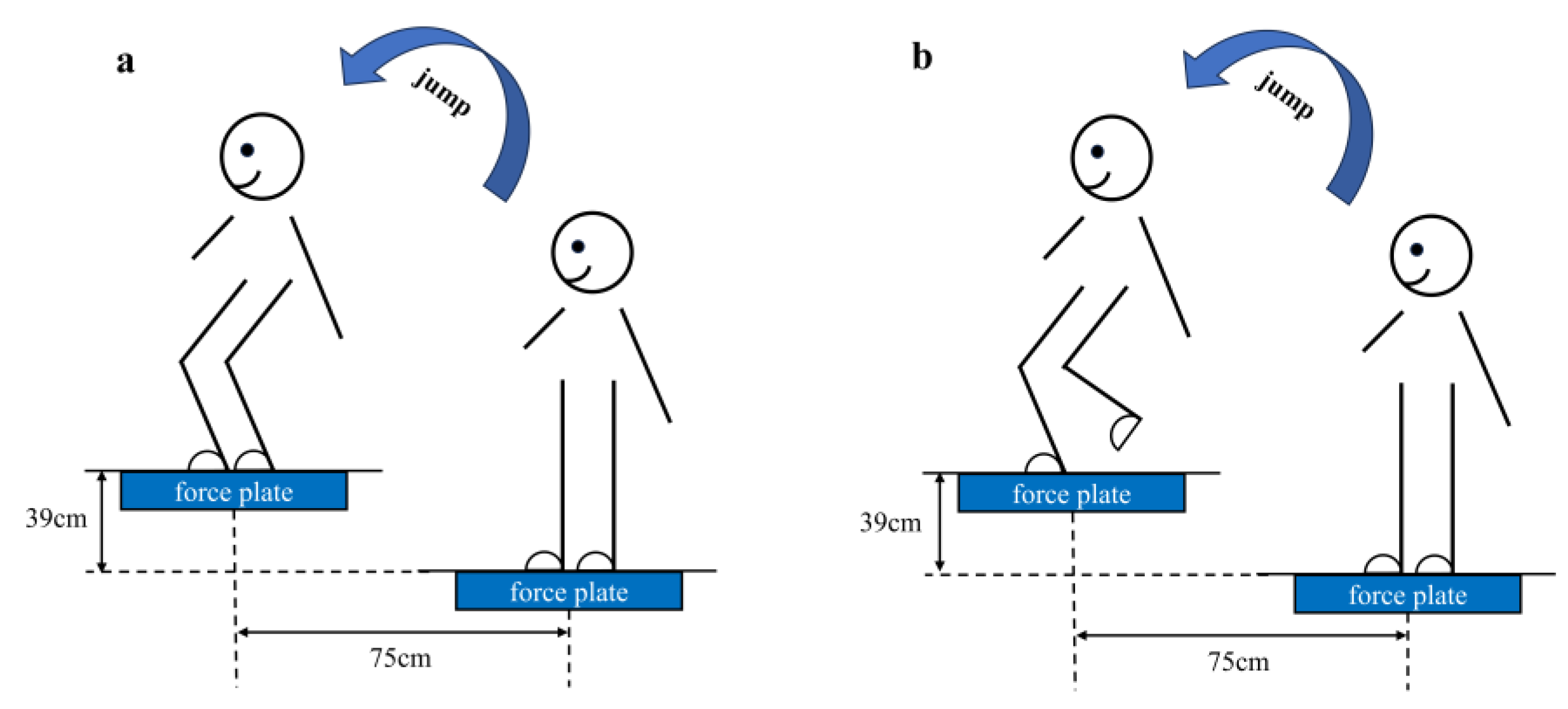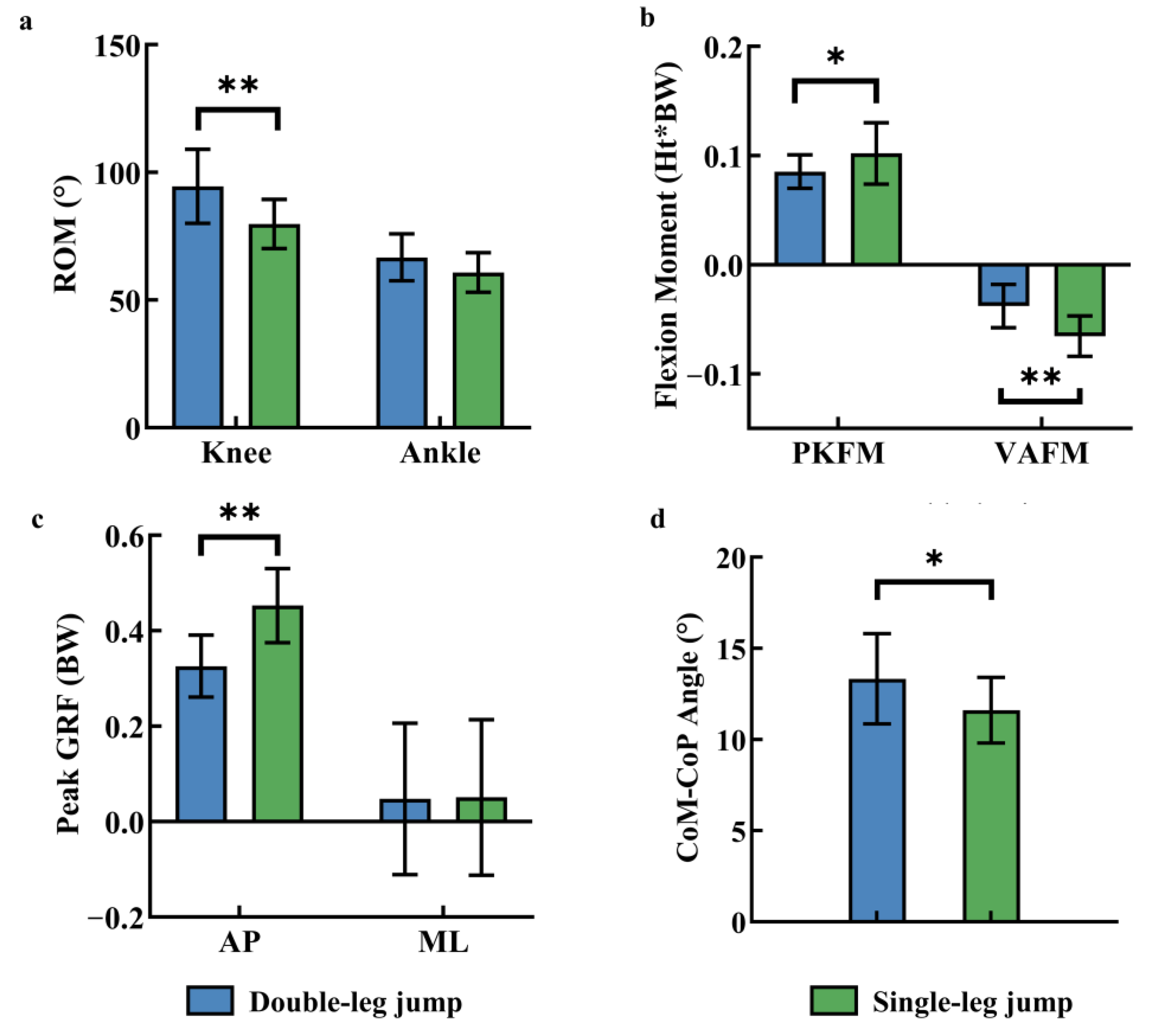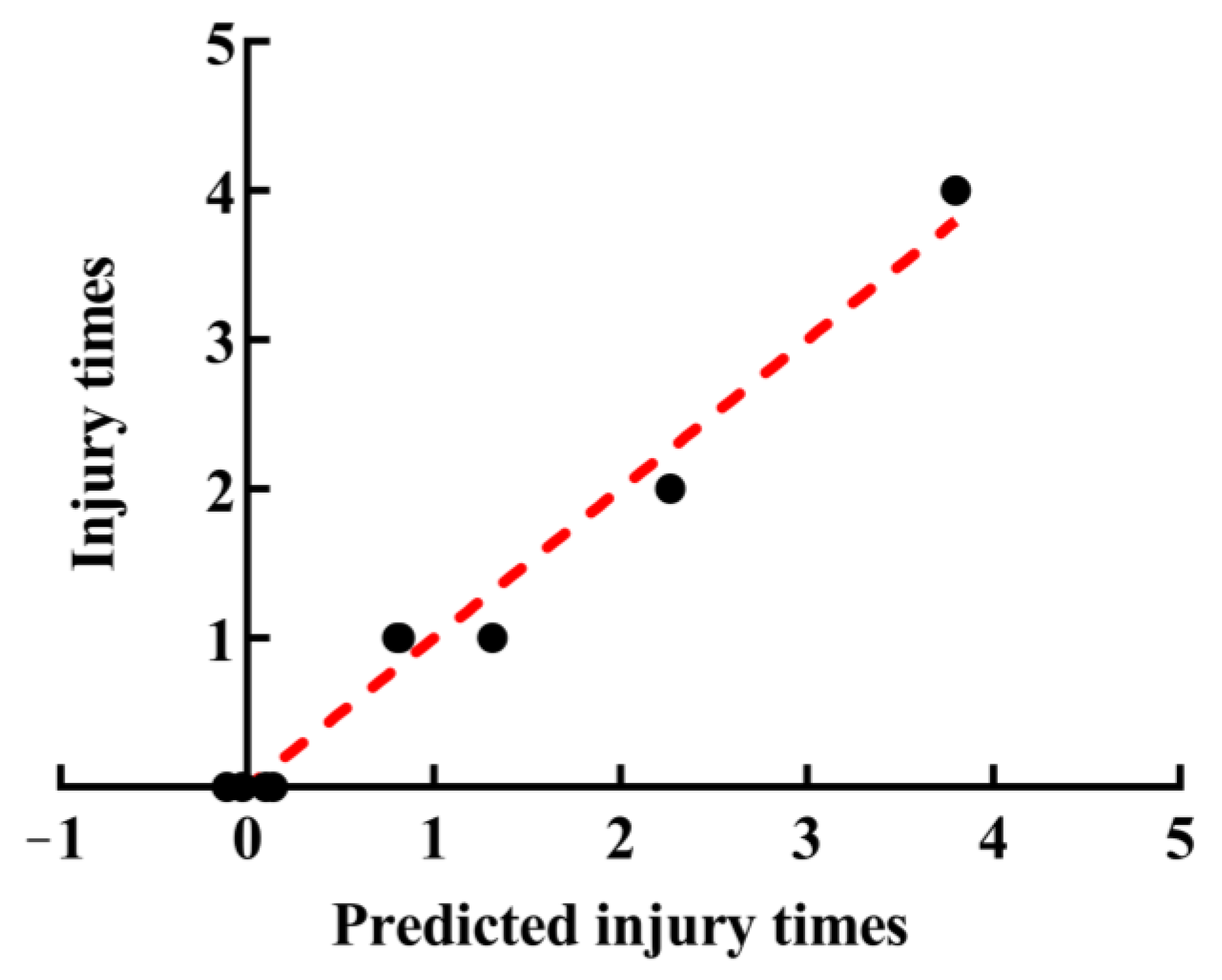The Injury Risk Prediction of Firefighters with Biomechanical Parameters during Single- and Double-Leg Jumps
Abstract
1. Introduction
2. Materials and Methods
2.1. Participants
2.2. Functional Movement Screen
2.3. Jump Landing Tasks
2.4. Data Collection
2.5. Data Processing
2.6. Statistical Analysis
3. Results
3.1. Injury Characteristics
3.2. FMS Scores
3.3. Kinematic and Dynamic Parameters
3.4. Stepwise Multiple Linear Regression
4. Discussion
4.1. Range of Joint Flexion Angle
4.2. Joint Flexion Moment
4.3. Peak GRF
4.4. CoM-CoP Angle
4.5. Limitations
5. Conclusions
Author Contributions
Funding
Institutional Review Board Statement
Informed Consent Statement
Data Availability Statement
Conflicts of Interest
References
- Tahernejad, S.; Farahi-Ashtiani, I.; Veisani, Y.; Ghaffari, S.; Sahebi, A.; Makki, F. A Systematic Review and Meta-Analysis of Musculoskeletal Disorders among Firefighters. J. Saf. Res. 2023, 88, 374–381. [Google Scholar] [CrossRef] [PubMed]
- Webb, H.E.; McMinn, D.R.; Garten, R.S.; Beckman, J.L.; Kamimori, G.H.; Acevedo, E.O. Cardiorespiratory Responses of Firefighters to a Computerized Fire Strategies and Tactics Drill during Physical Activity. Appl. Ergon. 2010, 41, 376–381. [Google Scholar] [CrossRef] [PubMed]
- Cañadas-De la Fuente, G.A.; Vargas, C.; San Luis, C.; García, I.; Cañadas, G.R.; Emilia, I. Risk Factors and Prevalence of Burnout Syndrome in the Nursing Profession. Int. J. Nurs. Stud. 2015, 52, 240–249. [Google Scholar] [CrossRef] [PubMed]
- Norlund, S.; Reuterwall, C.; Höög, J.; Lindahl, B.; Janlert, U.; Birgander, L.S. Burnout, Working Conditions and Gender—Results from the Northern Sweden MONICA Study. BMC Public Health 2010, 10, 326. [Google Scholar] [CrossRef] [PubMed]
- Ziaei, M.; Esmaeili, H.; Zolaktaf, V. A Systematic Model to Identify and Reduce Work-Related Musculoskeletal Disorders in Firefighters, and Improve Their Function. J. Bodyw. Mov. Ther. 2023, 36, 125–132. [Google Scholar] [CrossRef] [PubMed]
- Cornell, D.J.; Gnacinski, S.L.; Ebersole, K.T. Functional Movement Quality of Firefighter Recruits: Longitudinal Changes from the Academy to Active-Duty Status. Int. J. Environ. Res. Public Health 2021, 18, 3656. [Google Scholar] [CrossRef] [PubMed]
- Liu, H.; Ding, H.; Xuan, J.; Gao, X.; Huang, X. The Functional Movement Screen Predicts Sports Injuries in Chinese College Students at Different Levels of Physical Activity and Sports Performance. Heliyon 2023, 9, e16454. [Google Scholar] [CrossRef] [PubMed]
- Chalmers, S.; Fuller, J.T.; Debenedictis, T.A.; Townsley, S.; Lynagh, M.; Gleeson, C.; Zacharia, A.; Thomson, S.; Magarey, M. Asymmetry during Preseason Functional Movement Screen Testing Is Associated with Injury during a Junior Australian Football Season. J. Sci. Med. Sport. 2017, 20, 653–657. [Google Scholar] [CrossRef] [PubMed]
- Alemany, J.A.; Bushman, T.T.; Grier, T.; Anderson, M.K.; Canham-Chervak, M.; North, W.J.; Jones, B.H. Functional Movement Screen: Pain versus Composite Score and Injury Risk. J. Sci. Med. Sport. 2017, 20, S40–S44. [Google Scholar] [CrossRef]
- Parenteau-G, E.; Gaudreault, N.; Chambers, S.; Boisvert, C.; Grenier, A.; Gagné, G.; Balg, F. Functional Movement Screen Test: A Reliable Screening Test for Young Elite Ice Hockey Players. Phys. Ther. Sport. 2014, 15, 169–175. [Google Scholar] [CrossRef]
- Sharma, J.; Heagerty, R.; Dalal, S.; Banerjee, B.; Booker, T. Risk Factors Associated with Musculoskeletal Injury: A Prospective Study of British Infantry Recruits. Curr. Rheumatol. Rev. 2019, 15, 50–58. [Google Scholar] [CrossRef]
- Taanila, H.; Suni, J.H.; Kannus, P.; Pihlajamäki, H.; Ruohola, J.P.; Viskari, J.; Parkkari, J. Risk Factors of Acute and Overuse Musculoskeletal Injuries among Young Conscripts: A Population-Based Cohort Study. BMC Musculoskelet. Disord. 2015, 16, 104. [Google Scholar] [CrossRef] [PubMed]
- Richmond, S.A.; Kang, J.; Emery, C.A. Is Body Mass Index a Risk Factor for Sport Injury in Adolescents? J. Sci. Med. Sport. 2013, 16, 401–405. [Google Scholar] [CrossRef] [PubMed]
- Connaboy, C.; Eagle, S.R.; Johnson, C.; Flanagan, S.; Mi, Q.I.; Nindl, B.C. Using Machine Learning to Predict Lower-Extremity Injury in US Special Forces. Med. Sci. Sports Exerc. 2019, 51, 1073–1079. [Google Scholar] [CrossRef] [PubMed]
- Hogg, J.A.; Vanrenterghem, J.; Ackerman, T.; Nguyen, A.D.; Ross, S.E.; Schmitz, R.J.; Shultz, S.J. Temporal Kinematic Differences throughout Single and Double-Leg Forward Landings. J. Biomech. 2020, 99, 109559. [Google Scholar] [CrossRef] [PubMed]
- Lee, H.-J.; Chou, L.-S. Detection of Gait Instability Using the Center of Mass and Center of Pressure Inclination Angles. Arch. Phys. Med. Rehabil. 2006, 87, 569–575. [Google Scholar] [CrossRef] [PubMed]
- Lee, J.; Shin, C.S. Association between Ankle Angle at Initial Contact and Biomechanical ACL Injury Risk Factors in Male during Self-Selected Single-Leg Landing. Gait Posture 2021, 83, 127–131. [Google Scholar] [CrossRef] [PubMed]
- Bates, N.A.; Ford, K.R.; Myer, G.D.; Hewett, T.E. Impact Differences in Ground Reaction Force and Center of Mass between the First and Second Landing Phases of a Drop Vertical Jump and Their Implications for Injury Risk Assessment. J. Biomech. 2013, 46, 1237–1241. [Google Scholar] [CrossRef] [PubMed]
- Willems, T.M.; De Clercq, D.; Delbaere, K.; Vanderstraeten, G.; De Cock, A.; Witvrouw, E. A Prospective Study of Gait Related Risk Factors for Exercise-Related Lower Leg Pain. Gait Posture 2006, 23, 91–98. [Google Scholar] [CrossRef]
- Hewett, T.E.; Myer, G.D.; Ford, K.R.; Heidt Jr, R.S.; Colosimo, A.J.; McLean, S.G.; Van den Bogert, A.J.; Paterno, M.V.; Succop, P. Biomechanical Measures of Neuromuscular Control and Valgus Loading of the Knee Predict Anterior Cruciate Ligament Injury Risk in Female Athletes: A Prospective Study. Am. J. Sports Med. 2005, 33, 492–501. [Google Scholar] [CrossRef]
- Zadpoor, A.A.; Nikooyan, A.A. The Relationship between Lower-Extremity Stress Fractures and the Ground Reaction Force: A Systematic Review. Clin. Biomech. 2011, 26, 23–28. [Google Scholar] [CrossRef] [PubMed]
- Lopes, A.D.; Mascarinas, A.; Hespanhol, L. Are Alterations in Running Biomechanics Associated with Running Injuries? A Systematic Review with Meta-Analysis. Braz. J. Phys. Ther. 2023, 27, 100538. [Google Scholar] [CrossRef]
- Lempke, A.F.D.; Whitney, K.E.; Collins, S.E.; d’Hemecourt, P.A.; Meehan III, W.P. Biomechanical Running Gait Assessments across Prevalent Adolescent Musculoskeletal Injuries. Gait Posture 2022, 96, 123–129. [Google Scholar] [CrossRef]
- Markolf, K.L.; Burchfield, D.M.; Shapiro, M.M.; Shepard, M.F.; Finerman, G.A.; Slauterbeck, J.L. Combined Knee Loading States That Generate High Anterior Cruciate Ligament Forces. J. Orthop. Res. 1995, 13, 930–935. [Google Scholar] [CrossRef] [PubMed]
- Withrow, T.J.; Huston, L.J.; Wojtys, E.M.; Ashton-Miller, J.A. The Effect of an Impulsive Knee Valgus Moment on in Vitro Relative ACL Strain during a Simulated Jump Landing. Clin. Biomech. 2006, 21, 977–983. [Google Scholar] [CrossRef]
- Boden, B.P.; Torg, J.S.; Knowles, S.B.; Hewett, T.E. Video Analysis of Anterior Cruciate Ligament Injury: Abnormalities in Hip and Ankle Kinematics. Am. J. Sports Med. 2009, 37, 252–259. [Google Scholar] [CrossRef] [PubMed]
- Podraza, J.T.; White, S.C. Effect of Knee Flexion Angle on Ground Reaction Forces, Knee Moments and Muscle Co-Contraction during an Impact-like Deceleration Landing: Implications for the Non-Contact Mechanism of ACL Injury. Knee 2010, 17, 291–295. [Google Scholar] [CrossRef] [PubMed]
- Owusu-Akyaw, K.A.; Kim, S.Y.; Spritzer, C.E.; Collins, A.T.; Englander, Z.A.; Utturkar, G.M.; Garrett, W.E.; DeFrate, L.E. Determination of the Position of the Knee at the Time of an Anterior Cruciate Ligament Rupture for Male Versus Female Patients by an Analysis of Bone Bruises. Am. J. Sports Med. 2018, 46, 1559–1565. [Google Scholar] [CrossRef] [PubMed]
- Sasaki, S.; Koga, H.; Krosshaug, T.; Kaneko, S.; Fukubayashi, T. Kinematic Analysis of Pressing Situations in Female Collegiate Football Games: New Insight into Anterior Cruciate Ligament Injury Causation. Scand. J. Med. Sci. Sports 2018, 28, 1263–1271. [Google Scholar] [CrossRef]
- Grassi, A.; Smiley, S.P.; Roberti di Sarsina, T.; Signorelli, C.; Marcheggiani Muccioli, G.M.; Bondi, A.; Romagnoli, M.; Agostini, A.; Zaffagnini, S. Mechanisms and Situations of Anterior Cruciate Ligament Injuries in Professional Male Soccer Players: A YouTube-Based Video Analysis. Eur. J. Orthop. Surg. Traumatol. 2017, 27, 967–981. [Google Scholar] [CrossRef]
- Atkinson, P.J.; Haut, R.C. Injuries Produced by Blunt Trauma to the Human Patellofemoral Joint Vary with Flexion Angle of the Knee. J. Orthop. Res. 2001, 19, 827–833. [Google Scholar] [CrossRef] [PubMed]
- Favre, J.; Clancy, C.; Dowling, A.V.; Andriacchi, T.P. Modification of Knee Flexion Angle Has Patient-Specific Effects on Anterior Cruciate Ligament Injury Risk Factors During Jump Landing. Am. J. Sports Med. 2016, 44, 1540–1546. [Google Scholar] [CrossRef] [PubMed]
- Scattone Silva, R.; Purdam, C.R.; Fearon, A.M.; Spratford, W.A.; Kenneally-Dabrowski, C.; Preston, P.; Serrao, F.V.; Gaida, J.E. Effects of Altering Trunk Position during Landings on Patellar Tendon Force and Pain. Med. Sci. Sports Exerc. 2017, 49, 2517–2527. [Google Scholar] [CrossRef] [PubMed]
- De Bleecker, C.; Vermeulen, S.; De Blaiser, C.; Willems, T.; De Ridder, R.; Roosen, P. Relationship Between Jump-Landing Kinematics and Lower Extremity Overuse Injuries in Physically Active Populations: A Systematic Review and Meta-Analysis. Sports Med. 2020, 50, 1515–1532. [Google Scholar] [CrossRef] [PubMed]
- Lim, B.O.; An, K.O.; Cho, E.O.; Lim, S.T.; Cho, J.H. Cho Differences in Anterior Cruciate Ligament Injury Risk Factors between Female Dancers and Female Soccer Players during Single- and Double-Leg Landing. Sci. Sports 2021, 36, 53–59. [Google Scholar] [CrossRef]
- Zhang, Y.; Tao, C.; Zhang, X.; Guo, J.; Fan, Y. Effects of Cane Use on the Kinematic and Kinetic of Lower-Extremity Joints in Inexperienced Users. J. Biomech. 2023, 146, 111426. [Google Scholar] [CrossRef] [PubMed]
- Jafarnezhadgero, A.A.; Hamlabadi, M.P.; Sajedi, H.; Granacher, U. Recreational Runners Who Recovered from COVID-19 Show Different Running Kinetics and Muscle Activities Compared with Healthy Controls. Gait Posture 2022, 91, 260–265. [Google Scholar] [CrossRef] [PubMed]
- Mekhael, M.; Labaki, C.; Bizdikian, A.J.; Bakouny, Z.; Otayek, J.; Yared, F.; Massaad, A.; Skalli, W.; Ghanem, I.; Assi, A. How Do Skeletal and Postural Parameters Contribute to Maintain Balance during Walking? Human. Mov. Sci. 2020, 72, 102658. [Google Scholar] [CrossRef]
- Xu, R.; Wang, X.; Yang, J.; He, F.; Zhao, X.; Qi, H.; Zhou, P.; Ming, D. Comparison of the COM-FCP Inclination Angle and Other Mediolateral Stability Indicators for Turning. BioMed Eng. OnLine 2017, 16, 37. [Google Scholar] [CrossRef]





| Participants | Score |
|---|---|
| 1 | 17.0 |
| 2 | 17.0 |
| 3 | 18.0 |
| 4 | 18.5 |
| 5 | 17.5 |
| 6 | 11.0 |
| 7 | 18.5 |
| 8 | 13.0 |
| 9 | 15.5 |
| 10 | 15.0 |
| Mean ± SD | 16.1 ± 2.5 |
| Variables | Coeff. (SE) | 95% CI | p |
|---|---|---|---|
| DLJ-PKFM | −241.5880 (41.8157) | −323.5487–−159.6272 | 0.0103 |
| DLJ-VAFM | −146.1730 (20.9038) | −187.1436–−105.2022 | 0.0060 |
| DLJ-MPA | −0.5595 (0.2149) | −0.9808–−0.1383 | 0.0802 |
| SLJ-KFA | 0.2070 (0.0434) | 0.1219–0.2921 | 0.0175 |
| SLJ-PKFM | 117.3770 (21.6048) | 75.0324–159.7218 | 0.0122 |
| SLJ-MPA | −0.7269 (0.3005) | −1.3159–−0.1379 | 0.0943 |
| Variables | Coeff. (SE) | 95% CI | p |
|---|---|---|---|
| DLJ-KFA | 0.2618 (6.7806) | 0.1861–0.3374 | 0.0066 |
| DLJ-PKFM | −188.5167 (−9.7477) | −226.4217–−150.6118 | 0.0023 |
| DLJ-MPA | −1.4335 (−5.8184) | −1.9163–0.9506 | 0.0101 |
| SLJ-PKFM | 116.7351 (9.7704) | 93.3179–140.1523 | 0.0023 |
| SLJ-AP GRF | −10.4907 (−4.1361) | −15.4619–5.5195 | 0.0257 |
| SLJ-MPA | −0.5482 (−4.8501) | −0.7697–0.3266 | 0.0167 |
Disclaimer/Publisher’s Note: The statements, opinions and data contained in all publications are solely those of the individual author(s) and contributor(s) and not of MDPI and/or the editor(s). MDPI and/or the editor(s) disclaim responsibility for any injury to people or property resulting from any ideas, methods, instructions or products referred to in the content. |
© 2024 by the authors. Licensee MDPI, Basel, Switzerland. This article is an open access article distributed under the terms and conditions of the Creative Commons Attribution (CC BY) license (https://creativecommons.org/licenses/by/4.0/).
Share and Cite
Zhang, G.; Tao, P.; Chen, J.; Wang, Z.; Xu, R. The Injury Risk Prediction of Firefighters with Biomechanical Parameters during Single- and Double-Leg Jumps. Appl. Sci. 2024, 14, 4636. https://doi.org/10.3390/app14114636
Zhang G, Tao P, Chen J, Wang Z, Xu R. The Injury Risk Prediction of Firefighters with Biomechanical Parameters during Single- and Double-Leg Jumps. Applied Sciences. 2024; 14(11):4636. https://doi.org/10.3390/app14114636
Chicago/Turabian StyleZhang, Guanzheng, Pengyu Tao, Jingwen Chen, Ziyao Wang, and Rui Xu. 2024. "The Injury Risk Prediction of Firefighters with Biomechanical Parameters during Single- and Double-Leg Jumps" Applied Sciences 14, no. 11: 4636. https://doi.org/10.3390/app14114636
APA StyleZhang, G., Tao, P., Chen, J., Wang, Z., & Xu, R. (2024). The Injury Risk Prediction of Firefighters with Biomechanical Parameters during Single- and Double-Leg Jumps. Applied Sciences, 14(11), 4636. https://doi.org/10.3390/app14114636






